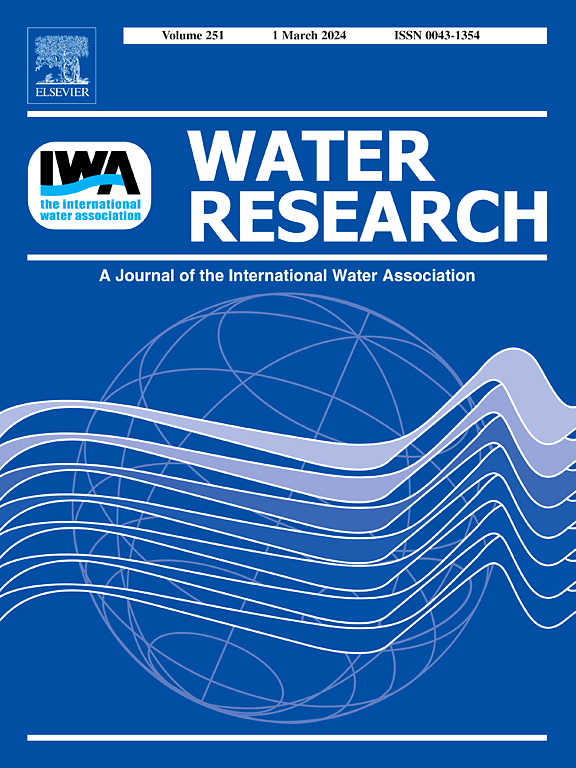碳酸氢盐促进烃类厌氧生成活性氧:表面氧化官能团活化和六价铬去除
IF 11.4
1区 环境科学与生态学
Q1 ENGINEERING, ENVIRONMENTAL
引用次数: 0
摘要
碳氢化合物在阳光下通过激活分子氧产生活性氧(ROS)。然而,碳氢化合物是否以及如何在黑暗和厌氧环境中产生ROS仍然未知。研究发现,在碱性条件下,烃类与共存的碳酸氢盐结合可产生超氧自由基(O2•−),其最大浓度可达24.7 μmol L−1。有趣的是,O2•−的生成不受去除分子氧的影响,而是高度依赖于烃类表面氧化官能团(OFGs)的丰度。电化学分析、密度泛函理论计算和表面表征结果表明,碳酸氢盐首先在球内与表面ofg络合,然后电子从碳酸氢盐转移到ofg。这使得OFGs内部的氧被激活为活性氧(O*),而碳酸氢盐被氧化为碳酸盐自由基(CO3•-)。CO3•-进一步通过氧转移机制与O*反应生成O2•-。生成的O2•−用于Cr(VI)处理,可有效还原95%以上为Cr(III)。这些发现为开发基于碳氢化合物的高级氧化工艺提供了新的途径,并突出了碳氢化合物在黑暗和厌氧水环境中由ROS介导的污染物转化中的潜力。本文章由计算机程序翻译,如有差异,请以英文原文为准。

Bicarbonate Boosts the Anaerobic Generation of Reactive Oxygen Species by Hydrochar: Surface Oxygenated Functional Groups Activation and Hexavalent Chromium Removal
Hydrochar can generate reactive oxygen species (ROS) via activating molecular oxygen under sunlight. However, whether and how hydrochar generates ROS in the dark and anaerobic environments remains unknown. Herein, we found that combining hydrochar with the co-existing bicarbonate could generate superoxide radicals (O2•−) under alkaline conditions, with the maximum concentration reaching 24.7 μmol L−1. Interestingly, the O2•−generation was not affected by eliminating the molecular oxygen but highly depended on the abundance of the oxygenated functional groups (OFGs) on hydrochar surface. The results of electrochemical analysis, density functional theory calculation, and surface characterization elucidated that the bicarbonate first inner-sphere complexed with surface OFGs, followed by the electron transfer from bicarbonate to OFGs. This enabled the activation of oxygen inside OFGs into active oxygen (O*) while bicarbonate was oxidized to carbonate radical (CO3•-). The CO3•- further reacts with O* through an oxygen transfer mechanism, resulting in the generation of O2•-. The generated O2•− was used for the Cr(VI) treatment, which could efficiently reduce over 95% into Cr(III). The findings provide a novel pathway for developing hydrochar-based advanced oxidation processes and highlight the potential of hydrochar in pollutant transformation mediated by ROS in dark and anaerobic water environments.
求助全文
通过发布文献求助,成功后即可免费获取论文全文。
去求助
来源期刊

Water Research
环境科学-工程:环境
CiteScore
20.80
自引率
9.40%
发文量
1307
审稿时长
38 days
期刊介绍:
Water Research, along with its open access companion journal Water Research X, serves as a platform for publishing original research papers covering various aspects of the science and technology related to the anthropogenic water cycle, water quality, and its management worldwide. The audience targeted by the journal comprises biologists, chemical engineers, chemists, civil engineers, environmental engineers, limnologists, and microbiologists. The scope of the journal include:
•Treatment processes for water and wastewaters (municipal, agricultural, industrial, and on-site treatment), including resource recovery and residuals management;
•Urban hydrology including sewer systems, stormwater management, and green infrastructure;
•Drinking water treatment and distribution;
•Potable and non-potable water reuse;
•Sanitation, public health, and risk assessment;
•Anaerobic digestion, solid and hazardous waste management, including source characterization and the effects and control of leachates and gaseous emissions;
•Contaminants (chemical, microbial, anthropogenic particles such as nanoparticles or microplastics) and related water quality sensing, monitoring, fate, and assessment;
•Anthropogenic impacts on inland, tidal, coastal and urban waters, focusing on surface and ground waters, and point and non-point sources of pollution;
•Environmental restoration, linked to surface water, groundwater and groundwater remediation;
•Analysis of the interfaces between sediments and water, and between water and atmosphere, focusing specifically on anthropogenic impacts;
•Mathematical modelling, systems analysis, machine learning, and beneficial use of big data related to the anthropogenic water cycle;
•Socio-economic, policy, and regulations studies.
 求助内容:
求助内容: 应助结果提醒方式:
应助结果提醒方式:


